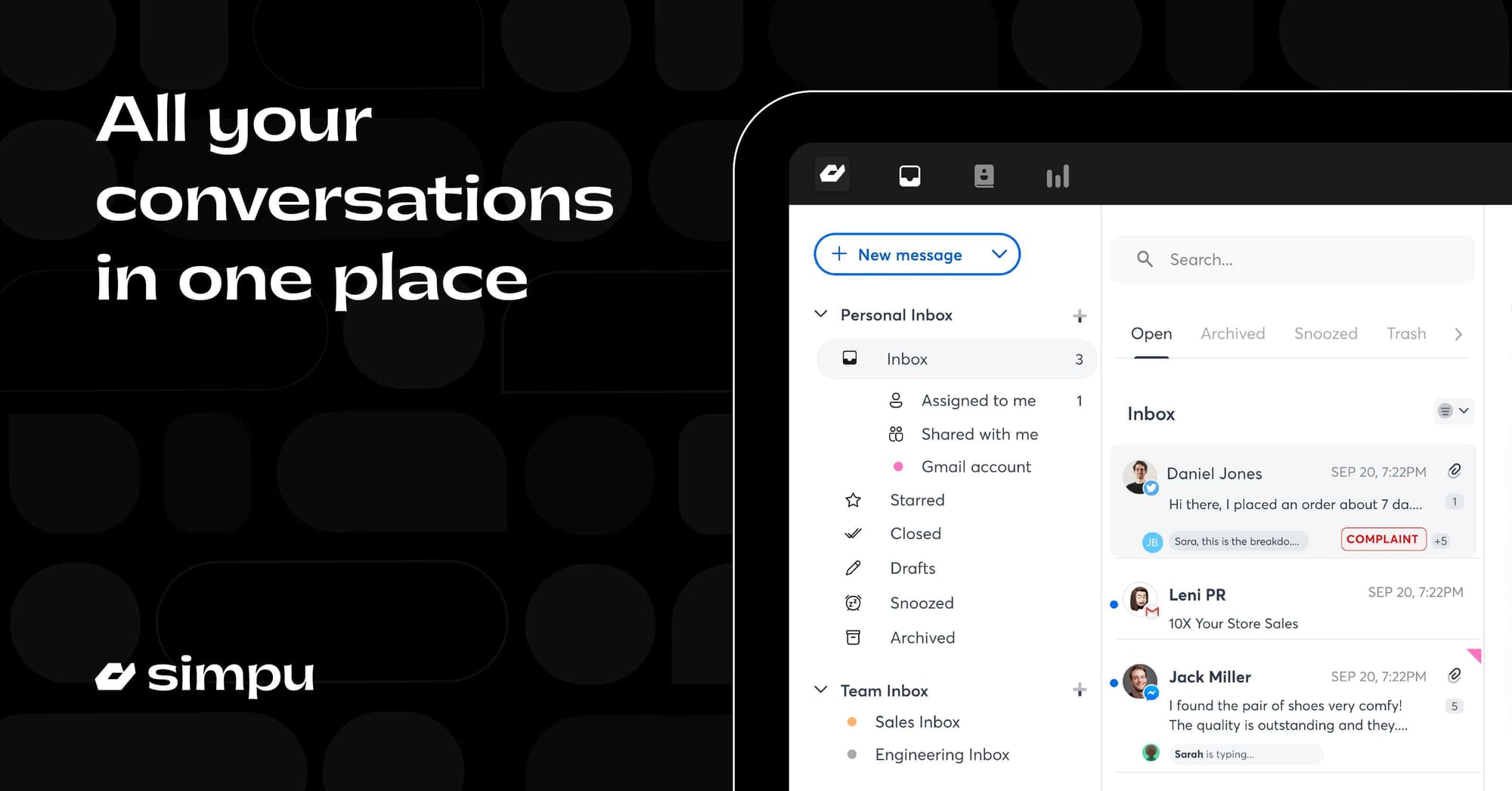In the world of e-commerce, exceptional customer service is everything. In a market where customers can easily find what they need with a few clicks of a button, the quality of the shopping experience is what sets brands apart.
The competition is fierce, and a business that fails to provide excellent customer service will quickly find itself struggling to survive.
When you consistently deliver exceptional customer service, you’ll cultivate loyal customers who can promote your business for you.
Your satisfied customers will occasionally share their stories of how your excellent customer service helped them out to their friends and family - this can bring in more happy customers, as well as increase overall brand awareness
In this article, we'll explore why delivering excellent customer service is crucial for establishing loyalty in e-commerce.
We'll delve into the impact that customer service has on customer retention, how it can help build trust with your customers, and the importance of going above and beyond to exceed their expectations.
Understanding the role of customer service in brand loyalty.
One of the most significant factors in building brand loyalty is customer service.
When a customer has a positive experience with a business's customer service team, they are more likely to return in the future and recommend the brand to others. On the other hand, a negative customer service experience can quickly turn a customer away from the brand for good.
This is because customer service plays a crucial role in establishing trust between a business and its customers. When customers feel that a company genuinely cares about their needs and is willing to go above and beyond to meet them, they are more likely to develop a sense of loyalty to that brand.
On the other hand, a bad customer service experience can make you lose customers. An angry customer will share their negative experience with other customers causing you to lose more sales. The most successful e-commerce brands use technical ways to deliver good customer service.
In summary, the role of customer service in brand loyalty is critical. By providing excellent customer service and building trust with customers, businesses can establish a loyal customer base that will keep coming back time and time again.

Shared Inbox
Connect all your communication channels - email, SMS, Whatsapp, Instagram, Messenger, and Live Chat to one inbox.
Building a customer-centric e-commerce brand.
To build a customer-centric e-commerce brand, it's crucial to invest in quality service and proactively helpful support teams. This means addressing customer complaints promptly and resolving issues as efficiently as possible.
The customer should always come first in any business, and e-commerce is no exception. Placing the customer at the center of your e-commerce brand means prioritizing their needs and providing good service every time customers interact with you. This approach not only helps you retain customers but also attracts new ones through recommendations.
On the other hand, poor customer service can quickly lead to negative reviews and damage your brand's reputation online.
That’s why it's essential to invest in quality service and proactively helpful support teams that address customer complaints and resolve issues promptly.
In addition to providing good customer service, businesses can also build a customer-centric brand by tailoring their products and services to meet the unique needs of their customers.
This might involve personalizing the shopping experience, offering targeted promotions or discounts, or providing helpful resources and advice.
Essential tips for building a customer-centric brand.
Putting your customers first is a crucial aspect of building a successful e-commerce business. Here are some ways to prioritize your customers and create a customer-centric brand:
- Conduct customer research.
Conducting research to understand your customers' needs, preferences, and pain points is key to building a customer-centric brand. This can involve surveys, interviews, or analyzing customer feedback. By gaining insights into your customers' behavior, you can tailor your products and services to meet their needs and provide solutions that address their concerns.
- Provide good customer service examples.
Providing customer service examples can set the tone for your service culture.
Train your support teams on best practices for customer service and provide them with the tools they need to do their job effectively. Incentivize your teams to provide great service by rewarding them for positive feedback or recognizing them publicly for their efforts.
- Address angry customers proactively.
When customers have issues or complaints, it's important to respond promptly and offer solutions that address their concerns.
This helps turn negative experiences into positive ones and creates customers who feel heard and valued. By being proactive and addressing issues quickly, you can prevent negative reviews and damage to your brand reputation.
- Implement your customer feedback.
Use feedback from customers to identify areas for improvement and implement changes that address these concerns.
Regularly review your customer service metrics to ensure that you meet your response, resolution, and satisfaction targets. This helps you identify areas where you can improve and shows customers that you are committed to providing excellent service.
5 steps to providing the best customer support online.
To provide exceptional customer support in e-commerce, you must focus on the customer's experience. You can deliver excellent customer service by taking these 5 simple steps:
Step 1: Hire and train skilled service agents.
Hiring the right people is critical to providing excellent customer support. Service agents should not only be knowledgeable about the products and services offered by the business, but they should also possess excellent communication and problem-solving skills.
Providing proper training to service agents is also essential in ensuring that they have the necessary skills to handle various types of customer inquiries or complaints.
Step 2: Be reachable everywhere.
Providing customers with multiple channels to reach out to the business can help improve the overall customer experience.
Customers have different preferences, and offering channels like email, phone, and live chat can accommodate their needs. Ensuring that these channels are easy to access and available during convenient hours is also crucial.

Step 3: Respond quickly and with empathy.
Customers expect quick responses, and providing a prompt response can help establish trust and improve their satisfaction.
It is also important to give an empathetic response, acknowledge the customer's concerns, and provide a solution that meets their needs. Service agents should also be trained to remain calm and polite even in challenging situations.
Step 4: Personalize the experience.
Using customer data to personalize interactions can help build a stronger connection between the business and the customer.
For example, providing personalized recommendations based on their purchase history can enhance their experience and create a sense of being valued. It is essential to ensure that the use of customer data is in compliance with privacy regulations.
Step 5: Follow up with customers.
After you've provided a solution to a customer's inquiry or complaint, follow up to ensure that the issue has been resolved to their satisfaction. Send a personalized message thanking them for their business and asking for feedback on their experience.
This can help you identify any lingering issues or concerns and address them before they become bigger problems. It can also show you care about their experience which makes customers happy.
How to speed up your customer support processes.
Here are some customer service tips to help you streamline your customer support processes, improve efficiency, and reduce response times:
- Collaborate with a shared inbox.
Using a shared inbox is a highly effective way to simplify and streamline your customer support processes.
This powerful tool provides a centralized location for your entire support team to effectively manage customer requests from all communication platforms simultaneously.
With shared team inboxes, you can combine channels like WhatsApp, Twitter DMs, Instagram DMs, Messenger, Live Chat, Gmail, Outlook, and 3rd Party Email Providers into a single view for seamless collaboration.
This means that you won't have to switch between different communication channels to manage customer inquiries, which can be time-consuming and overwhelming. Instead, you can focus on providing excellent service and support to your customers, which is crucial for building loyalty and trust.
- Automate responses to common questions.
To improve the efficiency of your customer support process, you can leverage automation to handle common inquiries. This includes using chatbots, which are becoming more prevalent in customer support. Chatbots are automated programs that can provide real-time assistance to customers by answering common questions.
With Simpu, users can easily create multiple chatbots to handle specific customer inquiries, freeing up support agents to focus on more complex issues. Additionally, Simpu's chatbots can provide 24/7 support, ensuring that customers can receive assistance at any time.
This not only improves the speed and accuracy of support but also enhances the overall customer experience.
- Implement self-help options.
Offering self-help options is a great way to enhance your customer support experience. By providing a knowledge base or FAQ section, customers can easily find answers to their questions and resolve issues without needing to reach out to a support agent.
This not only saves time for both parties but also reduces the volume of inquiries that require human intervention. By empowering customers to find solutions on their own, you can improve their overall experience and increase satisfaction with your e-commerce brand.
- Prioritize requests.
Not all customer inquiries are created equal. Some inquiries require immediate attention, while others can wait. Prioritizing customer inquiries helps you allocate resources more effectively and respond to urgent requests faster.
To achieve this, businesses must identify factors such as the severity of an issue, the customer's history with the company, and the level of impact on the customer's business to determine which requests require immediate attention and which ones can wait.
- Provide continuous training.
One of the key ways to improve the quality of customer support in an e-commerce business is through continuous training of support agents.
By providing ongoing training, businesses can ensure that their support agents stay up-to-date on product/service knowledge, and are equipped with the skills needed to handle customer queries and complaints effectively.
Continuous training can include a variety of learning opportunities such as online courses, coaching sessions, role-playing exercises, and workshops. These training methods can help support agents gain new skills, learn about new products or services, and develop their problem-solving and communication skills.
Create memorable experiences for your customers
Creating memorable experiences for your customers is all about making them feel valued and special.
With Simpu, you can take personalization to the next level by using customer data to tailor your interactions. You'll build a stronger connection with your customers when you recommend products based on their interests or send them personalized messages.
As the saying goes, "People will forget what you said, people will forget what you did, but people will never forget how you made them feel." So, why not make your customers feel good and stand out from your competitors?
Think of your customers as friends, and engage with them on topics you know they are interested in. By doing so, you build a connection and show that you share similar values and interests. This creates a positive association with your brand, and customers are more likely to return and recommend your business to others.
Remember, the key is to create a personalized experience that resonates with your customers. By doing so, you'll create a lasting impression and build a loyal customer base.
Key points to consider for crafting a personalized shopping experience.
Personalizing the shopping experience in e-commerce is no longer an option, it's a necessity. Customers are looking for more than just a product. They want a company that understands their needs and exceeds their expectations.
Here are the best ways to personalize your customer experience
- Understand their needs.
Understanding your customers' needs is essential for providing them with personalized experiences. When you understand what your customers are looking for, you can tailor your marketing efforts and customer service to meet their specific needs.
By understanding your customers' needs, you can create personalized experiences that make them feel valued and heard. This can lead to increased customer loyalty and advocacy, as well as positive word-of-mouth recommendations to others.
- Deliver more personalized experiences backed by data.
Personalization is a crucial aspect of building a loyal customer base, and data is a powerful tool that can be used to create personalized experiences for customers.
With Simpu, users can get to know more about your customers, you can see your conversation history.
Simpu shows you your customer data, such as purchase history, browsing behavior, and preferences, businesses can make targeted product recommendations that are relevant to each customer.
Simpu's advanced customer experience platform also allows you to send personalized SMS and email campaigns.
Personalized promotions and discounts can be offered based on customers' shopping behavior. For example, if a customer frequently purchases organic food products, they can be offered a discount on a new organic food line.
This not only encourages repeat business but also shows the customer that the business values their preferences.
- Leverage user-generated content.
User-generated content (UGC) can be a powerful way to personalize the customer experience. UGC includes product reviews, customer photos, and other content generated by your customers. By sharing UGC on your website and social media channels, you can provide a more authentic and personalized experience for your customers. UGC can also help build trust and credibility with potential customers who are researching your products.
- Use personalization to upsell and cross-sell.
Personalization can also be used to upsell and cross-sell products to customers. By using customer data to understand their preferences and past purchases, you can make personalized recommendations for complementary products or more expensive options.
This can increase the average order value and improve your bottom line. For example, if a customer has purchased a pair of shoes from your website, you can use personalization to offer them a matching handbag or accessories.
- Personalize the post-purchase experience.
Personalization shouldn't stop once the customer has made a purchase. Personalizing the post-purchase experience can help build customer loyalty and increase the chances of repeat business.
This can include personalized order confirmation emails, shipping notifications, and follow-up emails asking for feedback or offering discounts for future purchases. For example, sending a personalized email with a discount code for the customer's next purchase can help improve customer retention.
Leveraging technology for improved customer service.
You need to adopt innovative customer service technologies to meet the evolving needs of customers. Jumia is one of the largest e-commerce companies in Africa, operating in over a dozen countries. They offer a wide range of products, from electronics to fashion, and have become known for their excellent customer service.
Jumia's chatbots handle a variety of customer inquiries, from order tracking to product information. By using chatbots, they provide quick and efficient customer service to their customers, freeing up their human representatives to handle more complex inquiries.
Here are simple tools you should adopt to provide great customer service.
- Chatbots.
A chatbot is a computer program that can simulate conversations with human users through text or voice commands.
They can handle a wide range of customer inquiries, from answering basic questions to providing product recommendations. They help you provide 24/7 customer service without the need for human intervention.
Simpu chatbots are an efficient solution for handling simple and routine customer queries. By automating these queries, your customer service representatives can concentrate on more complicated ones, thereby enhancing overall productivity. You won't need to hire additional staff, which can save you money.
Additionally, Simpu enables you to create different chatbots for various customer segments based on their inquiries.
- Live chat.
The live chat feature enables customers to have real-time communication with a customer service representative via a chat interface. By using this feature, you can give your customers a more personalized experience while efficiently addressing their concerns. Compared to phone support, live chat is cost-effective since it requires fewer resources.
With live chat, you can proactively offer customer service by identifying customers who are experiencing difficulties with a specific product or service and providing immediate assistance. Furthermore, you can use live chat to offer personalized recommendations for upselling and cross-selling products.
- Social media.
Today's consumers expect businesses to be active on social media and respond to their inquiries quickly. Social media provides an effective platform to address customer queries, concerns, and complaints in real time.
By utilizing social media channels, businesses can proactively provide support and engage with customers. It also helps in creating brand awareness and establishing a personal connection with customers. However, managing multiple social media accounts can be overwhelming, and sharing passwords with multiple people can be a security risk.
Simpu's shared inbox can help you to manage your social media interactions by allowing you to connect multiple channels in one place and choose who has access to it.
- Email support.
Email support is a form of customer service that allows customers to submit inquiries or questions through email and receive a response from a customer support agent within a specific timeframe. It is a popular and traditional customer service channel that many e-commerce businesses still use today.
One of the advantages of email support is its cost-effectiveness. Unlike other channels, it requires fewer resources and personnel to manage customer inquiries.
With Simpu's shared team inbox, you can seamlessly manage customer inquiries from multiple email accounts. Additionally, you can create a unique branded email for your support inquiries to stay on brand.
- Video support.
Video support allows customers to interact with a customer support agent through video conferencing technology, providing a more personalized and interactive experience. It can be used to provide demonstrations of products or services, troubleshoot issues, and provide product recommendations.
Video support enables customers to engage with support agents in real time, which is particularly beneficial for resolving complex issues that necessitate visual demonstrations or hands-on troubleshooting. By integrating Zoom with Simpu, you can seamlessly jump on a call with your customers directly from the chat interface.
- Artificial intelligence (AI)
AI technology can help businesses analyze customer data to provide personalized recommendations and improve the overall customer service experience. AI-powered chatbots can handle simple inquiries and provide customers with quick and accurate answers, freeing up support agents to handle more complex issues.
Additionally, AI can be used to monitor customer sentiment and identify areas for improvement, allowing businesses to address issues before they become major problems.

Measure the impact of excellent customer service on brand loyalty.
Customer loyalty is a crucial factor for business success. Here are the key metrics you can use to measure the impact of your service on customer loyalty.
- Net promoter score (NPS).
The Net Promoter Score (NPS) is a simple and effective way to measure customer loyalty. It is calculated by asking customers how likely they are to recommend your business to a friend or colleague on a scale of 0 to 10.
Customers who respond with a score of 9 or 10 are considered promoters, while those who respond with a score of 0 to 6 are known as detractors. The NPS is calculated by subtracting the percentage of detractors from the percentage of promoters.
- Customer churn rate.
Customer churn rate refers to the percentage of customers who stop doing business with your company over a specific period. By tracking your churn rate, you can see how changes in customer service affect your customer retention.
To calculate your churn rate, you need to divide the number of customers lost during a specific period by the total number of customers at the beginning of that period.
For example, if you lost 50 customers in a month, and you had 1000 customers at the beginning of the month, your churn rate would be 5%.
- Customer lifetime value (CLV).
Customer Lifetime Value (CLV) is a metric that measures the total value that a customer brings to your business over their lifetime. It takes into account the number of purchases a customer makes, the average purchase value, and the average retention time. By tracking your CLV, you can see how changes in customer service affect customer loyalty and the overall value of your customer base.
To calculate your CLV, multiply the average purchase value by the number of purchases per year, and then multiply that number by the average customer lifespan. For example, if your average purchase value is $50, your customers make two purchases per year, and the average retention time is five years, your CLV would be $500.
- Customer satisfaction (CSAT).
One way to measure customer satisfaction is to ask them to rate their level of satisfaction with a specific interaction or experience on a numerical scale. For instance, you may ask customers to rate their satisfaction with a recent customer service interaction on a scale of 1 to 5 or 1 to 10.
With Simpu, you can easily collect feedback from customers by sending them a feedback link after a chat has been closed.
Customers can rate their interaction with your support agent, allowing you to identify areas of improvement and evaluate your team's performance. This feedback can also help you recognize your best-performing agents and take steps to improve your customer service.
In conclusion, excellent customer service is crucial for building brand loyalty in e-commerce. By prioritizing customer service, you can earn your customers' trust, build a loyal customer base, and drive business growth.
Remember, a positive customer experience can lead to repeat business, while a negative experience can lead to lost customers. Make sure you invest in your customer service teams and give them what they need to deliver great customer service.
Start your journey with Simpu today and enjoy a 14-day free trial. Elevate your customer experience with seamless checkout.

Inbox
Connect all your communication channels - email, SMS, Whatsapp, Instagram, Messenger, and Live Chat to one inbox.









